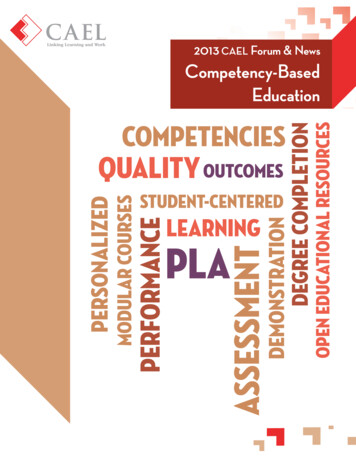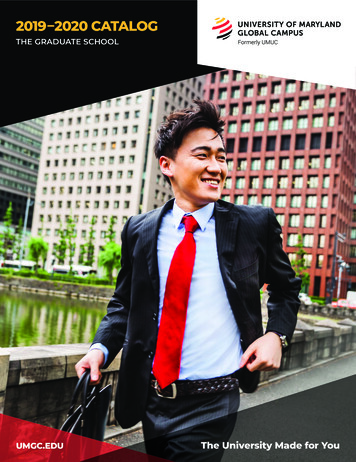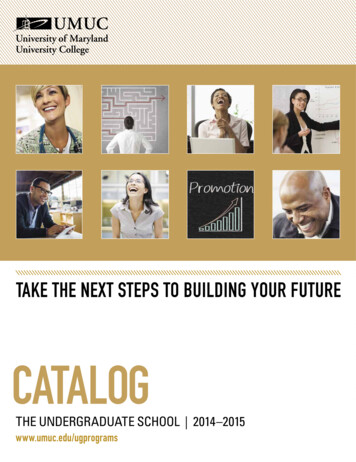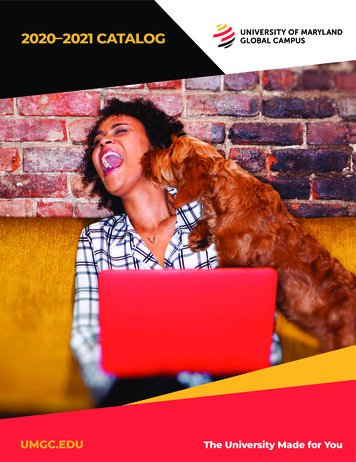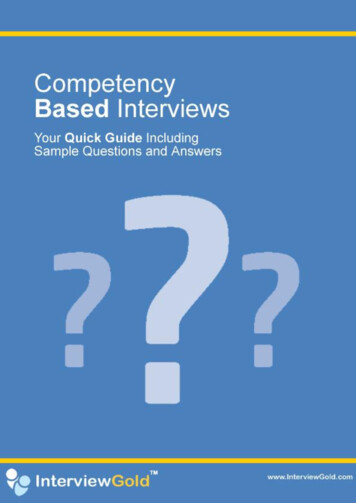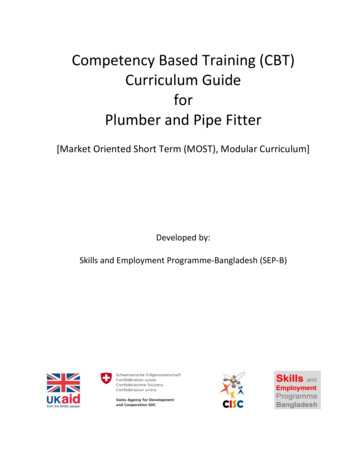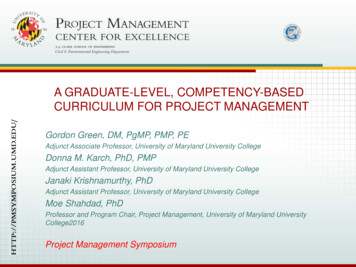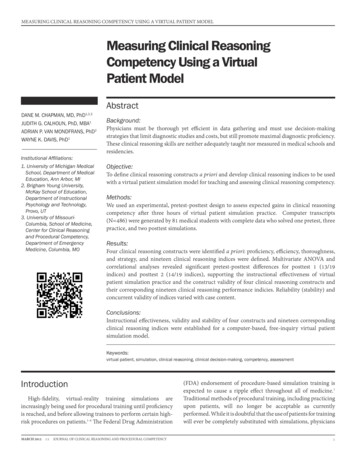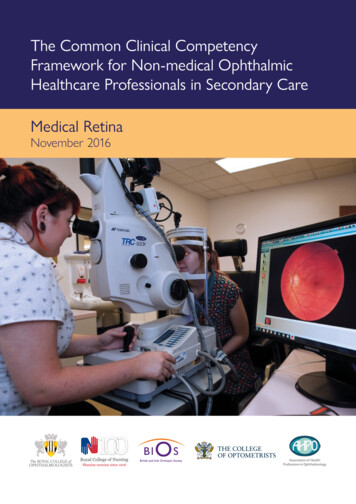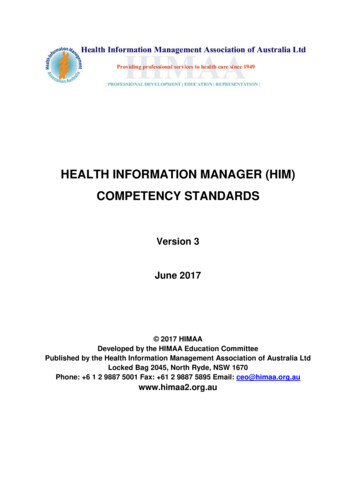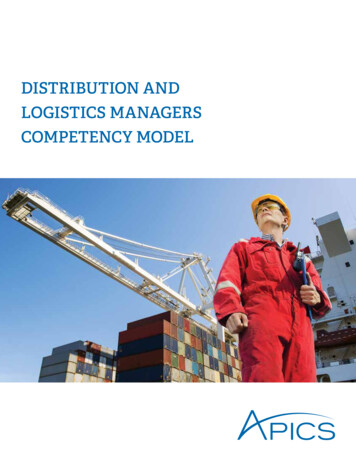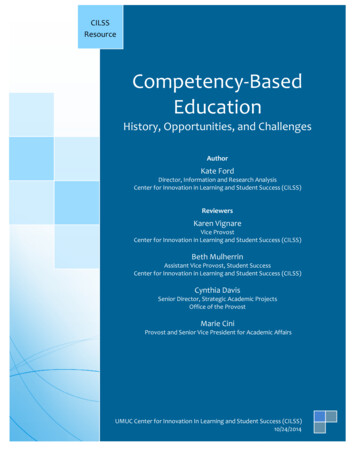
Transcription
CILSSResourceCompetency-BasedEducationHistory, Opportunities, and ChallengesAuthorKate FordDirector, Information and Research AnalysisCenter for Innovation in Learning and Student Success (CILSS)ReviewersKaren VignareVice ProvostCenter for Innovation in Learning and Student Success (CILSS)Beth MulherrinAssistant Vice Provost, Student SuccessCenter for Innovation in Learning and Student Success (CILSS)Cynthia DavisSenior Director, Strategic Academic ProjectsOffice of the ProvostMarie CiniProvost and Senior Vice President for Academic AffairsUMUC Center for Innovation In Learning and Student Success (CILSS)10/24/2014
Competency-Based EducationDespite significant recent media and public policy attention, competency-based educationand training is not a new concept. It has evolved from early vocational education models tomore robust and complex approaches to learning in higher education. This literature reviewtraces some major landmarks in the growth of competency-based education (CBE), including thedevelopment of concepts of curriculum mapping and competency frameworks, the current stateof CBE implementation, and challenges remaining.Historical OverviewModern competency-based education and training movements here and abroad beganwith U.S. efforts to reform teacher education and training in the 1960s (Brown, 1994; Hodges &Harris, 2012; and Tuxworth, 1994/1989). In fact, Brown (1994) described sequential“generations” of competency-based learning and suggested that the models that emerged in the1980s and early 1990s actually represented the fifth generation of the competency model.Brown’s historical account, largely informed by Australia’s competency-based vocationaleducation model, traced the development through the first generation – the application ofscientific management to work roles – then the second -- the development of mastery learningmodels in the U.S. during the 1920s and 1930s. He suggested that the third generation ofcompetency-based approaches was primarily concerned with formative vocational education andtraining, and reflected instructional design informed by psychology: namely, the work of B.F.Skinner, hence the association with behaviorism.The teacher education movement in the U.S. represented the fourth generation, movingbeyond vocational training to education. This is when the word “competency” began to be usedwidely in association with this model of instruction and learning, and when a number of conceptsassociated with modern competency-based learning came to the fore. For example, measurable,behavioral objectives were used to specify what a learner should be able to “do” and at whatlevel (standards-based performance) following training. Brown also pegged the introduction ofsystematic instructional design and curriculum development to this era. Underlying the transitionfrom one generation of competency-based approaches to the next is the increased focus onoutcomes, versus process. Brown noted that, “one of the characteristics that has always beenUMUC Center for Innovation In Learning and Student Success (CILSS) Briefing Paper1
Competency-Based Educationassociated with CBT is that it is highly contentious as an approach to education and training” (p.11).Jones and Voorhees (2002) examined fourth and fifth generation competency-basedprograms targeting adult learners in the U.S. They found that most programs in postsecondaryeducation focused on development and transferability of competency or outcome-based curriculain specific disciplines and to a lesser extent, specific workplace skills and institutionaleffectiveness. One effort in particular, Oregon’s Proficiency-Based Admission StandardsSystem, attempted to bridge the competency gap between secondary and postsecondaryeducation. Oregon’s reforms prompted interest in similar programs in 20 other states, includingMaryland. Nevertheless, Spady (1977) described these early K-12 initiatives as a largely“ uncoordinated movement,” one that was “ rapidly transforming into a bandwagon thatpromises to be the Great American Educational Fad of the 1970's” (p.9).Outside of secondary and higher education, the competency-based education movementalso influenced the design and delivery of vocational education in the UK and particularly inAustralia, where national reforms in the late 1980s and early 1990s required that all accreditedvocational education programs be competency-based (Hodges & Harris, 2012). Additionally,Tuxworth (1994/1989) suggested that competency-based approaches were a prominent feature ofhealth-care related education, training and professional development. However, in theirextensive review of the literature from 1966 to 2002, Carraccio, Wolfsthal, Englander, Frerentz,and Martin (2002) found that efforts to apply competency-based models to medical educationand training essentially stalled at the conceptual level. They found that most reform effortscentered on identifying general competencies and learning outcomes. According to the authors,both the failure to link curriculum and residency training to specific competencies and the lack ofvalid assessment tools and methods for evaluation of competencies limited the extent to whichmedical and health-related education providers were able to operationalize competency-basedlearning approaches.Klein-Collins (2013) also documented the rise of competency-based education (CBE)programs in the U.S., noting that, “An intensive focus on what students know and can do ratherthan on what is taught, for instance, is a hallmark of CBE programs going back at least fourUMUC Center for Innovation In Learning and Student Success (CILSS) Briefing Paper2
Competency-Based Educationdecades” (p.4). According to Klein-Collins, increased interest in and federal funding support forthe expansion of higher education opportunities to working adults in the 1970s led to thedevelopment of several well-known outcome and/or competency-based degree programs atAlverno College, DePaul University’s School for New Learning, Empire State College,Excelsior College (previously Regents College), and Thomas Edison State College. A keydistinguishing feature of these early programs was their emphasis on learning outcomes andassessment of learning outcomes. Typically, competencies were embedded in the curriculum,though related advancements in prior learning assessment via portfolios and standardized testsaccompanied these efforts.Based on the historical accounts of competency-based education (CBE) in the literature,one could reasonably argue that online learning, advances in learning analytics and adaptivelearning technology, and the operationalization of direct assessment models to entire collegedegree programs (versus post-secondary vocational education) signaled an evolutionary shifttoward a sixth generation of competency-based education models. Until recently, CBE programswere primarily a “niche” offering targeting the adult learning segment of the higher educationmarket space. Recent calls for increased productivity, effectiveness, and demonstrable outcomesfrom the education sector have prompted expanded global interest in the development of majorcompetency-based education initiatives. According to Klein-Collins (2013), “CBE’s sharp focuson student competencies is designed to validate the quality of the degree, and its technologybased approach to learning has the potential to lower cost” (p. 5).In her first extensive report on competency-based education programs produced for theCouncil for Adult and Experiential Learning, Klein-Collins (2012) described what may beanother distinguishing feature of sixth-generation CBE programs -- the increased emphasis ondirect assessment of competencies rather than instructor-led courses. Although some of the morerecently developed CBE programs -- including those offered by Delaware County CommunityCollege, Rio Salado, and Brandman University -- follow Alverno College’s more traditionalapproach of positioning competency frameworks within course-based programs designed aroundcredit hours, other programs offered by Western Governors University, Westminster College,and Southern New Hampshire University’s new College for America do not. Rather, studentsearn their degrees by successfully completing a series of project-based assessments that enableUMUC Center for Innovation In Learning and Student Success (CILSS) Briefing Paper3
Competency-Based Educationthem to demonstrate whether they have mastered the stated competencies. Students are assisted,rather than taught, by coaches and mentors, who may also be responsible for curating contentthat students may need to help master a given competency. Additionally, tuition for these typesof programs is typically based on a six-month “all you can learn” flat-rate subscription model,which may enable some students to advance faster than a traditional semester or time-basedmodel.In summary, the application of CBE models to degree programs can be described aseither evolutionary or revolutionary. On the one hand, direct assessment models that decouplethe concept of mastery from the credit hour enable some students to complete their degreerequirements sooner. Time is variable rather than fixed for each student. For example, a studentwith significant accounting experience may already possess the knowledge and skill levelexpected of all learners at the end of accounting 101and can immediately move to demonstrationof mastery through assessment. Yet, in most cases, including Western Governors University,curriculum and competency credits are still mapped back to credit hours, to facilitate vertical andlateral credit transfer (Klein-Collins 2012). Additional research is needed to determine towhether any given implementation of CBE results in superior learning outcomes and efficienciesfor different learner demographics or institutional settings.An Emphasis on AlignmentThe concept of curriculum mapping appears repeatedly in the competency-basededucation (CBE) literature and underscores the need for alignment at all levels of CBE, fromconception and design through assessment and reporting. Various frameworks have also beendeveloped to aid in the development of competencies outlining what graduates should know andbe able “to do” as a result of their education. As with CBE, competency frameworks are not anew concept. An historical review of the literature documents the use of competencyframeworks at the national, institutional, and program levels for well over 25 years. Forexample, Australian vocational education reforms, which were informed by CBE activity in theU.S. during the 1960s and 1970s, resulted in the development of the Australian StandardsFramework (ASF), to which accredited training courses in the country were aligned (Brown,1994). The related National Framework for Recognition of Training was designed to addressUMUC Center for Innovation In Learning and Student Success (CILSS) Briefing Paper4
Competency-Based Educationprior learning and competencies, irrespective of the manner in which they were acquired. In theU.S., the federal Department of Labor and various industry sectors, including manufacturing andautomotive, have established competency frameworks emphasizing stackable credentials toensure that a pipeline of skilled and knowledgeable labor is available to the workforce, and callscontinue for more extensive and coherent frameworks (Ganzglass, Bird, & Prince, 2011).In the higher education arena, Klein-Collins (2012, 2013) outlined a number of recentinitiatives aimed at articulating the knowledge, skills, and competencies that college-levellearners must develop and demonstrate in order to graduate. At the institution and programlevel, these frameworks are broad statements of learning outcomes and serve as the standardagainst which specific outcomes are assessed and measured. The “Essential LearningOutcomes” defined by the American Association of Colleges and Universities (AAC&U) and itsmember colleges as part of the Liberal Education and America’s Promise (LEAP) project offerone such example. LEAP covers broad knowledge areas, cognitive and practical skills, andemphasizes the application of the stated competencies to complex problems through the use ofrubric-based assessments.The Global Learning Qualifications Profile (GLQP) is an alternative frameworkdeveloped by Open SUNY, based in part on the LEAP project’s essential learning outcomes andrubrics. The GLQP emphasizes assessment of college-level outcomes obtained through openlearning sources including Open Educational Resources (OERs), Massive Open Online Courses(MOOCs) and prior or experiential learning. Development of the GLQP was also informed bythe Lumina Foundation’s Degree Qualifications Profile (DQP) (Travers & McQuigge, 2013).Lumina Foundation’s DQP has been positioned in the competency-based education andassessment literature as an adaptable higher education outcomes framework around whichindividual institutions can build their own outcome-oriented degree frameworks at theAssociate’s, Bachelor’s, and Master’s levels (Ewell 2013; Jankowski, Hutchings, Ewell, Kinzie,& Kuh, 2013; & Klein-Collins, 2012, 2013). It is similar to the European QualificationsFramework, which scaffolds the Bologna Process. The Bologna Process refers to the voluntaryagreement and process through which 47 European countries created the European HigherEducation Area. The participating countries sought to reduce the fragmentation of the EuropeanUMUC Center for Innovation In Learning and Student Success (CILSS) Briefing Paper5
Competency-Based Educationhigher education system and improve the mobility, employability and global competitiveness ofits graduates. The process involved standardizing degree program structure across membercountries and employing qualification frameworks to define specific programs and learningoutcomes. Similar to the European Qualifications Framework, the DQP is intended, at least inpart, to facilitate the portability of academic credentials, as defined by criterion-referencedlearning outcomes, across institutional and geographic boundaries. In the U.S., the DQP mayalso help address student “swirl” by improving the portability of college credits earned bystudents who transfer horizontally and/or vertically among multiple colleges or universitiesduring their college careers. By improving transparency, transferability, and recognition ofdegree credentials, frameworks have been positioned as serving the need for a highly educatedand geographically mobile workforce (Adelman, Ewell, Gaston, & Schneider, 2011; Ganzglass,Bird & Prince, 2011).The DQP is a top-down qualifications framework that speaks to learning outcomes andproficiencies at the credential or vertical degree level, rather than being discipline-specific. Itsdevelopment was informed by the Tuning USA project, another Bologna-inspired competencyframework initiative focused at the subject/discipline level (Adelman, 2010). The Tuning USAproject involved study groups of faculty and students from state university systems, communitycolleges and private institutions in Indiana, Minnesota, and Utah. These groups examined theEuropean process and its associated tools, and each group applied the “tuning” process to twodisciplines. According to Adelman (2010), tuning at the discipline level illuminatedcompetencies that spanned multiple degrees, both vertically and horizontally. Therefore,qualification frameworks that represent these competencies at various degree levels represented alogical extension of the tuning process. Design of a credential using a qualification frameworksuch as the DQP, according to Ewell (2013), brings a new degree of intentionality:“Intentionality should govern the goals we develop to define our degrees, the curricula andpedagogies we design and deploy to make the goals real, and the assessments we use todetermine if we have been successful” (p.7).The DQP defines educational outcomes in terms of what graduates know and can do.Lumina’s DQP emphasizes five learning areas (Adelman, Ewell, Gaston, & Schneider,2011,2014; Kallioinen, 2010). Revised in 2014, they are:UMUC Center for Innovation In Learning and Student Success (CILSS) Briefing Paper6
Competency-Based Education Specialized knowledge (what students in any specialization should demonstrate withrespect to the specialization beyond the vocabularies, theories and skills of particularfields of study); Broad integrative knowledge (consolidating learning from different broad fields ofstudy such as humanities, arts, sciences, and social sciences; Intellectual skills (traditional and nontraditional cognitive skills); Applied and collaborative learning; and Civic and global learning.As a framework, the DQP is designed to be both cumulative and integrative in terms ofhow knowledge and skills are developed and applied. (Adelman, Ewell, Gaston, & Schneider,2011; Ganzglass, Bird & Prince, 2011). The DQP has been used at over 400 colleges anduniversities in 45 states, including Brandman University, which launched its competency-basedframework in 2011, following a two-year redesign of learning outcomes and requirements for itsbachelor’s degree. According to Klein-Collins, (2012), Brandman’s competency-basedframework combines institution-specific outcomes with elements of AAC&U’s LEAP Outcomesand the DQP. Courses and learning outcomes assessments are also being developed orredesigned in concert with Brandman’s localized adaptation of the DQP. The WesternAssociation of Schools and Colleges, the Higher Learning Commission, the SouthernAssociation of Colleges and Schools, and the Council of Independent Colleges and Universitiesare participating along with several of their respective member schools in projects sponsored bythe Lumina Foundation to test and further develop the DQP, which is also a key reference pointin the redesign of the accreditation process for those schools (Ewell, 2013).The DQP neither specifies nor standardizes inputs, such as content or teaching methods(Ganzglass, Bird, & Prince, 2011). Ewell (2013), who was one of the authors of the DQP,pointed out that “DQP competencies are offered as statements of mastery, not aspiration” (p.7);therefore, a fully integrated approach to assessment of mastery is essential to ensure that allstudents possess the competencies set forth in the DQP. However, as Ewell observed, currentoutcomes assessment approaches at most U.S. colleges and universities are disconnected with theintentionality of the DQP approach, in that proof of outcomes has been treated largely as an“exoskeletal” or bolt-on process. Although capstone courses, student work portfolios, specificUMUC Center for Innovation In Learning and Student Success (CILSS) Briefing Paper7
Competency-Based Educationclass assignments, and other types of authentic assessments have become more common thanstandardized tests, according to Ewell, periodic sampling of student outcomes has remained thebasis on which most institutions approach public accountability. Rather than using periodic“check up” methods to assess teaching and learning effectiveness, he suggested that assessmentshould be deeply embedded or interwoven within a competency approach or framework. Thekey, argued Ewell, is the alignment of “progressively more challenging exercises, performances,and assignments for demonstrating student mastery at multiple points” (p. 8) with disciplinespecific competencies and the institutional competencies specified at the degree level in the formof a framework like the DQP.The process that Ewell (2013) outlined for achieving this alignment begins withcurriculum mapping, which is similar to the process of creating alignment matrices forinstitutional outcomes assessment. At minimum, this means mapping documents to detail wheremastery of a competency is expected and how it will be assessed. Activities and contentassociated with developing competency are also documented in thi
Competency-Based Education UMUC Center for Innovation In Learning and Student Success (CILSS) Briefing Paper 5 prior learning and competencies, irrespective of the manner in which they were acquired. In the U.S., the federal Department of Labor
